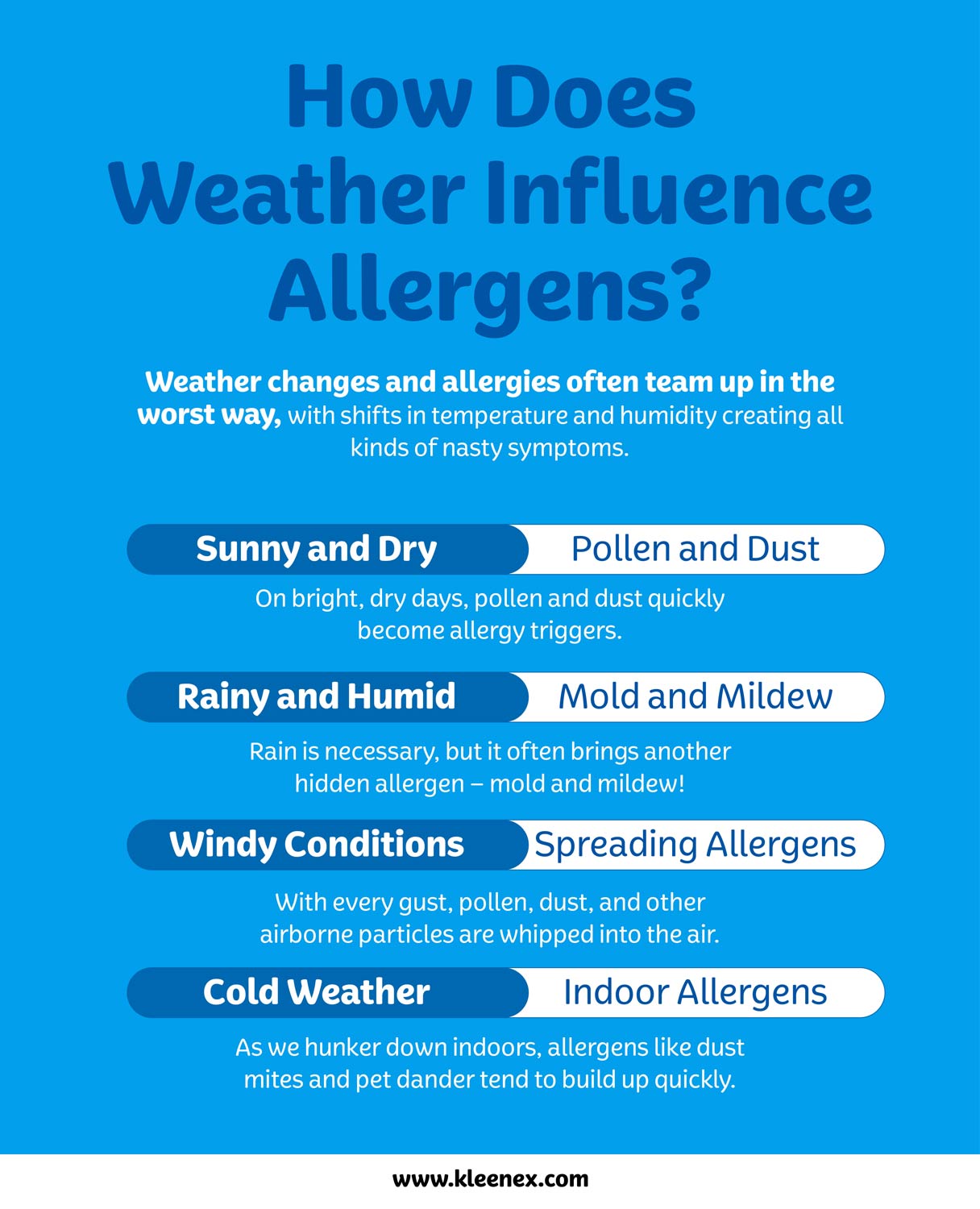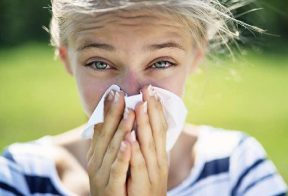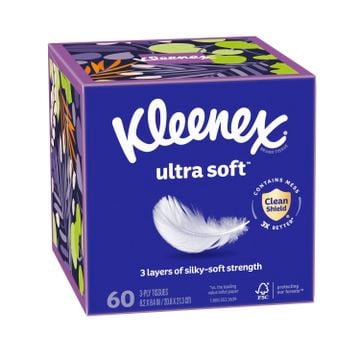
Allergy symptoms can sometimes come out of nowhere. While incredibly common, allergies tend to get worse when the seasons change. This is the result of an increase in pollen, rain, wind, temperature, humidity, and more. This can cause a range of symptoms that vary from person-to-person. Typically, this can include sinus pressure, scratchy throat, sneezing, watery eyes, to name a few. To help you and your family out, we’re sharing a list of home remedies for seasonal allergies to alleviate and treat your symptoms.
How Do Weather Conditions Influence Allergens?

Sunny and Dry: Pollen and Dust
On bright, dry days, pollen and dust quickly become allergy triggers. Pollen levels soar as trees, grasses, and flowers release it into the air. With no rain to weigh it down, it travels far and wide, making it nearly impossible to avoid. Every breath feels like you’re walking through a pollen cloud! Dust particles aren’t far behind either – stirring up with every breeze, leaving your eyes itchy, your sinuses irritated, and triggering endless sneezing fits.Rainy and Humid: Mold and Mildew
Rain is necessary, but it often brings another hidden allergen – mold and mildew! After a heavy downpour, the damp, humid air becomes a playground for mold spores, spreading far both outdoors and in. For those who are sensitive to mold, it’s a recipe for disaster, triggering coughing fits, wheezing, and stuffy noses. Additionally, that same humidity can create mildew growth indoors, making allergy symptoms even worse. Rain and allergies are an unwelcome duo in any household.Windy Conditions: Spreading Allergens
Windy conditions can also impact seasonal allergies. With every gust, pollen, dust, and other airborne particles are whipped into the air, spreading far beyond their original source. Suddenly, allergens are everywhere, traveling for miles and sneaking into your home through open windows or vents. On windy days, it feels like there’s no escape, as even the slightest breeze can cause flare-ups.Cold Weather: Indoor Allergens and Dry Air
When the cold weather hits, it’s not just the chill you have to worry about – cold weather and allergies often go hand in hand. As we hunker down indoors, allergens like dust mites and pet dander tend to build up quickly. With windows sealed shut and heating systems constantly running, these particles get trapped. On top of that, the dry air that comes with colder temperatures can irritate your nasal passages, making the discomfort from indoor allergens even worse, especially in poorly ventilated spaces.Seasonal Changes and Their Impact on Allergies
The Spring Pollen Explosion
Spring is infamous for setting off allergies as plants and flowers unleash a surge of pollen into the air. As everything blooms, pollen levels skyrocket, turning the season into something quite unforgiving for allergy sufferers. Spring allergy symptoms are the usual sneezing rallies, itchy eyes, and constant congestion that hits hard. If you’re sensitive to tree or grass pollens, spring can feel like a battle against nature.Sunlit Sniffles in Summer
Spring may get all the attention for its pollen encounters, but summer has its own tricks up its sleeve. As the weather heats up, grass and weed pollen take over, turning the season into a constant fight for those who are sensitive. Runny noses, sneezing fits, and itchy skin become all too familiar as the weed pollen count rises. And if that wasn’t enough, summer’s humidity creates the ideal environment for mold to thrive, adding another layer of dissatisfaction. Summer allergies don’t let up, making it also a season of unwanted sneezing.A Harvest of Hay Fever in Fall
As the air cools and leaves begin to tumble, fall allergy sufferers typically have to deal with ragweed. Ragweed pollen spreads like wildfire on breezy days, with its ultra-light particles traveling long distances. This triggers sneezes and sniffles along the way. But ragweed isn’t the only one at play – mold is also present, thriving on piles of fallen leaves in damp corners. For anyone sensitive to airborne spores, fall becomes a season of itchy eyes and clogged sinuses. It’s not just pumpkin spice in the air – it’s allergens galore.Winter’s Icy Grip with Allergy Drip
Winter might give you a break from outdoor allergens, but don’t get too comfortable – indoor allergy triggers kick into high gear! As we cozy up inside, dust mites, pet dander, and mold start to pile up. This is especially true in stuffy and poorly ventilated spaces like laundry rooms or corridors. With windows shut tight and the indoor air dry as a bone, your respiratory system takes a hit, leaving you coughing, sneezing, and wheezing. Winter may look calm and cozy, but for those sensitive to indoor allergens, it can be a season of non-stop sniffles.Quick Fixes for Preventing Allergy Symptoms
- Monitor Local Allergen Forecasts: Check daily allergen and pollen levels. This will help you to plan your outdoor adventures when pollen counts are low. This will enable you to enjoy the fresh air without the stress. Sign up for Kleenex® Pollen Pal alerts!
- Use Air Filters for HVAC Systems: Improve your indoor air quality by installing air filters in your HVAC system. These capture pollen, dust, pet dander, and other pollutants to help clean your air.
- Maintain Ideal Indoor Humidity: Keep humidity levels between 30-50% with a dehumidifier. This helps reduce dust mites and prevents mold growth.
- Create a Cleaning Routine: Regularly dust and vacuum your home, focusing on areas where allergens tend to accumulate.
- Change Clothes After Outdoor Activities: After spending time outside, change your clothes and take a shower to remove any pollen that may have clung to you.
Home Remedies for Allergy Symptoms
- Saline Nasal Rinse: Use saline spray to rinse your nasal passages. This can help remove allergens and reduce congestion, providing soothing relief.
- Essential Oils: Diffusing essential oils such as eucalyptus or lavender can help clear nasal congestion and promote relaxation.
- Warm Compress: Apply a warm compress over your sinuses to alleviate pressure. This can be a particularly helpful treatment for pollen allergy.
- Stay Hydrated: Drinking plenty of water helps thin mucus and keeps your airways moist. Aim for at least eight glasses daily - or more - if you’re active or live in a dry climate.
- Quercetin: This natural antihistamine can be found in foods like onions, apples, and berries. Adding these foods to your diet may help stabilize your allergies.
Breathe Easy with Kleenex® Facial Tissues
For everyday comfort, Kleenex® Ultra Soft™ Facial Tissues offers three silky-soft layers that are perfect for sensitive allergies. Hypoallergenic and free of dyes, fragrances, and lotion, they’re gentle enough for everyone.
But why stop there? To keep your entire home allergy-free, air filters for your HVAC system work behind the scenes to trap airborne allergens. By improving your indoor air quality, . Now, you’re fully equipped to take on allergens both inside and out!
Learn more about allergies with Kleenex®.







